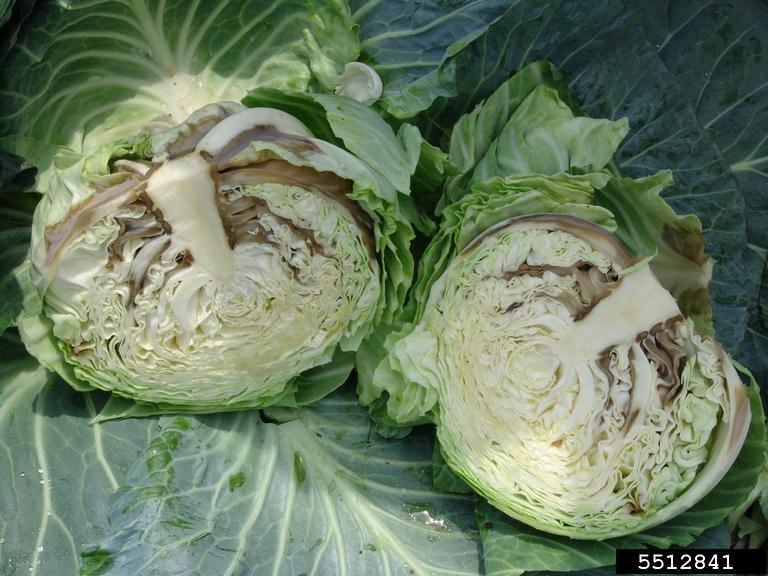In this Issue:
- Soil-Borne Bacteria: Understand what conditions allow Pectobacterium carotovorum to survive and affect potatoes and onions.
- Red Fire Bugs: These nuisance pests congregate in clusters on structures and plants.
- White Flies: Can affect a variety of vegetable pests in the greenhouse, high tunnels, and field.
- Lygus Bugs: Reported in Idaho’s Treasure Valley in alfalfa seed fields.
- Cabbage Maggots: Adults emerge in early May, larvae affect broccoli, cabbage, cauliflower, beets, etc.
Soil-Borne Bacteria (Pectobacterium carotovorum)
Overview

Bacterial pathogens are single-celled organisms that have a rigid cell wall but lack a membrane around the nucleus. One example is Pectobacterium carotovorum, which causes bacterial rots in multiple crops, especially potato and onion. P. carotovorum affects the bulbs or tubers by soaking and softening the inner flesh and causing it to turn a dark brown–black color. This disease is most common when soil temperatures are high (90°F and above) along with the presence of moisture.
Damage
Bacteria will enter through the wounds of plants then cause infection. P. carotovorum damages the bulbs or tubers by soaking and softening the inner flesh and causing it to turn a dark brown-black color.
Management
- There is no cure once plants are infected, therefore early management is essential.
- P. carotovorum spreads through water, so furrow, flooding, or overhead irrigation that leaves standing water may contribute to disease incidence.
- DO NOT bury or compost infected plant material.
Additional Resources
Bacterial Soft Rot (Wisconsin Extension)
Bacterial Soft Rot (Michigan Extension)
Red Fire Bug (Pyrrhocoris apterus)
Overview

Red Fire Bugs (Pyrrhocoris apterus) typically become active in April and May. Both adults and nymphs avoid direct sunlight and will be found in masses on structures or underneath plants.
Damage
Red Fire Bugs are not known to cause any direct damage to plants but are considered a nuisance.
Management
- Directly spray congregations with water to drown the insects.
- Use a spray with insecticidal soap.
- Consider using insecticides with the active ingredient pyrethroid (only if really needed).
Additional Resources
Red Fire Bugs (USU Fact Sheet)
Red Fire Bugs (USU School of IPM)
White Flies (Family: Aleyroidae)
Overview

Adults are 1.5-2.5 mm long, have white wings, and typically form large colonies during warm temperatures on the underside of leaves. Economic damage in Utah mostly occurs in greenhouses and high tunnels. Whiteflies are known to develop resistance to insecticides, so treatment is not generally recommended for homeowners or small production.
Damage
Both the adults and nymphs will use their piercing-sucking mouthparts to feed on various vegetable crops, especially those in the Cubiritcaceae and Solanaceae families. Affected plants will have leaves that turn yellow, appear dry, and eventually fall off. Similar to aphids, whiteflies will excrete a sugary substance called honeydew on the leaves.
Management
- Encourage natural enemies (beneficial insects) to the area such as parasitic wasps, lady beetles, and lacewings.
- Remove infested foliage or spray them down with water.
- Inspect transplants for any signs of whitefly populations before planting in the field.
- Set up sticky traps in greenhouse or high tunnel to monitor populations.
Additional Resources
IPM for Greenhouses and Nurseries (USU Extension)
White Flies (Maryland Extension)
Lygus Bug/Tarnished Plant Bug (Lygus lineolaris) | Western Tarnished Bug (Lygus Hesperus)

Overview
Adults can range from 4-6 mm long. They are brown with yellow, black, and red markings. They are identified by a triangle pattern on their upper back. Lygus bugs are commonly found in Utah and the crop damage can be an economic threat.
Damage
Damage has recently been reported on seed alfalfa in Idaho’s Treasure Valley, however, multiple vegetables are susceptible as well. Both adults and nymphs will use their piercing-sucking mouthparts to cause seeds to shrivel, discolor foliage, and prematurely drop buds, flowers, and fruits.
Management
- Commercial Insecticide options for Alfalfa seed fields
- Avoid planting vegetables near alternative hosts such as flowering weeds, legumes, and alfalfa.
Additional Resources
PNW Pest Alert (Lygus Bug on Alfalfa)
Lygus Bug (Pennsylvania Extension)
Cabbage Maggots (Delia radicum)
Overview

Adult flies typically emerge in early May, though sporadic in Utah this pest can cause serious economic loss to crops. Adult flies and larvae are both about half a centimeter long. The larvae (maggots) are white and are found on beets, broccoli, Brussels sprouts, cabbage, cauliflower, celery, collards, kohlrabi, radishes, turnips, and other brassicas.
Damage
The larvae will feed and tunnel through the taproots of host crops, which can cause wilting, reduced growth, and leave plants susceptible to fungal and bacterial decay.
Management
- Implement a crop rotation between suscetible crops and unrelated crops.
- Consider using raised soil beds to increase soil drying and warming.
- Remove all plant residue at the end of the season to prevent overwintering life stages.
- Insecticide options for home use (Root Maggots on Brassicas)
- Insecticide options for commercial use (Root Maggots on Brassicas)
Additional Resources
Brassica Pests – Root Maggots (USU Veg Guide)
Cabbage Root Maggot (Massachusetts Extension)
